| Article ID | Journal | Published Year | Pages | File Type |
|---|---|---|---|---|
| 1737922 | Journal of Environmental Radioactivity | 2015 | 7 Pages |
•To assure a safe utilization of phosphogypsum in agriculture.•To evaluate the lixiviation of metals end radionuclides from phosphogypsum used as soil amendment.•The results obtained for the concentration of the radionuclides and metals in the leachate were negligible.•To enhance scientific knowledge that will corroborate the recycling of a NORM residue and its use as by-product.
The main phosphate industries in Brazil are responsible for the annual production of 5.5 million tons of a residue (phosphogypsum), which is stored in stacks. The presence of radionuclides and metals puts restrictions on the use of phosphogypsum in agriculture. To assure a safe utilization, it is important to estimate the lixiviation of the radionuclides (238U, 226Ra, 210Pb, 210Po, 232Th and 228Ra) and metals (As, Cd, Cr, Ni, Se, Hg and Pb) present in phosphogypsum. For this purpose, an experiment was carried out, in which columns filled with sandy and clay Brazilian typical soils mixed with phosphogypsum were percolated with water, to achieve a mild extraction of these elements. The results obtained for the concentration of the radionuclides and metals in the leachate were low; giving evidence that, even when these elements are present in the phosphogypsum, they do not contribute to an enhancement of their content in water.
